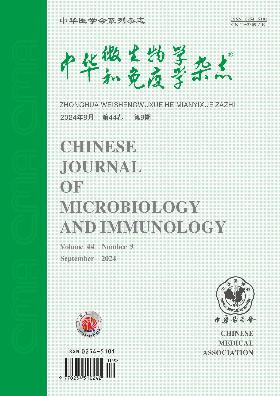中国中东部人群诺瓦克病毒GI.1和gi .4血清抗体
Q4 Immunology and Microbiology
引用次数: 0
摘要
目的检测诺如病毒(NoV) GⅠ。1-和GⅡ。从血清学角度了解诺如病毒在中国各年龄段健康人群中的流行病学特征,为疫苗研制和临床试验设计提供基础数据。方法采用间接ELISA法和hbga阻断法检测广州、阜阳、烟台3个地区健康人群(年龄6个月~ 88岁)血清中novo特异性IgG、IgA和hbga阻断抗体。对结果进行统计学分析。结果11 - G总阳性率Ⅰ。1-和GⅡ。4特异性IgG抗体分别为91.9%和93.0%。G的阳性率Ⅰ。1-和GⅡ。4特异性IgA抗体分别为48.6%和75.6%,hbga阻断抗体对G的滴度Ⅰ。1和GⅡ。4种诺如病毒分别为5.04 (95%CI: 4.63 ~ 5.49)和18.15 (95%CI: 16.11 ~ 20.44)。随着年龄的增长,IgG和IgA抗体阳性率普遍呈上升趋势。G的阳性率Ⅰ。1-和GⅡ。4-特异性IgG抗体在不同年龄组分别为79.2% ~ 100.0%和76.7% ~ 100.0%。0.5 ~ <1岁组分别为81.7%和85.0%,1 ~ <2岁组分别为79.2%和76.7%,12 ~ <18岁组分别为98.1%和96.3%,老年组保持在96%和98%。G的阳性率Ⅰ。1特异性IgA抗体在不同年龄组为11.7% ~ 93.8%,随年龄增长迅速升高。0.5 ~ <1岁年龄组为11.7%,45 ~ <60岁年龄组为93.3%,≥60岁年龄组为93.8%。G的阳性率Ⅱ。4特异性IgA抗体在不同年龄组的阳性率为50.8% ~ 88.8%,其中0.5 ~ <1岁人群阳性率为50.8%,12 ~ <18岁及以上人群阳性率为86.7% ~ 90.7%。G滴度Ⅰ.1hbga阻断抗体一般随年龄增加而增加。0.5 ~ <12岁人群的抗体滴度低于18岁及以上人群(GMT: 2.98 ~ 4.07 vs 8.21 ~ 11.62, P<0.001), 12 ~ <18岁人群的抗体滴度低于45岁及以上人群(GMT: 5.21 vs 11.03 ~ 11.62, P<0.05)。G滴度Ⅱ.4随年龄变化不明显hbga阻断抗体在2-<5岁和22-<45岁人群中差异显著(GMT: 26.73 vs 11.87, P<0.01)。结论本研究揭示了血清NoV G的特点Ⅰ。1-和GⅡ。通过分析中国中东部地区不同年龄组人群中4特异性IgG、IgA和HBGA阻断抗体的阳性率和滴度,为中国NoV疫苗的研制提供初步的血清流行病学资料。关键词:诺如病毒;血清抗体;Receptor-blocking化验本文章由计算机程序翻译,如有差异,请以英文原文为准。
Serum antibodies against norovirus GI.1 and GII.4 in populations in central and eastern China
Objective
To detect norovirus (NoV) GⅠ.1- and GⅡ.4-specific IgG, IgA and histo-blood group antigen (HBGA)-blocking antibodies in healthy populations of all age groups in China for better understanding the epidemiological features of norovirus in China from a serological point of view and providing basic data for vaccine development and clinical trial design.
Methods
Indirect ELISA and HBGA-blocking assay were used to detect NoV-specific IgG, IgA and HBGA-blocking antibodies in serum samples collected from healthy natural populations (n=839, aged from six months to 88 years old) in Guangzhou, Fuyang and Yantai. The results were statistically analyzed.
Results
The total positive rates of NoV GⅠ.1- and GⅡ.4-specific IgG antibodies were 91.9% and 93.0%. The positive rates of GⅠ.1- and GⅡ.4-specific IgA antibodies were 48.6% and 75.6%, and the titers of HBGA-blocking antibodies to GⅠ.1 and GⅡ.4 norovirus were 5.04 (95%CI: 4.63-5.49) and 18.15 (95%CI: 16.11-20.44). The positive rates of IgG and IgA antibodies generally showed an increasing trend with age. The positive rates of GⅠ.1- and GⅡ.4-specific IgG antibodies ranged from 79.2% to 100.0% and 76.7% to 100.0% in different age groups. They were 81.7% and 85.0% in the age group of 0.5-<1 year, 79.2% and 76.7% in the age group of 1-<2 years, and 98.1% and 96.3% in the age group of 12-<18 years, and maintained at 96% and 98% in the older age groups. The positive rates of GⅠ.1-specific IgA antibody ranged from 11.7% to 93.8% in different age groups and rapidly increased with age. It was 11.7% in the age group of 0.5-<1 year, and reached 93.3% in people aged 45-<60 years and 93.8% in people aged ≥60 years. The positive rates of GⅡ.4-specific IgA antibody ranged from 50.8% to 88.8% in different age groups with 50.8% in people aged 0.5-<1 year, and 86.7%-90.7% in people aged 12-<18 years and older. The titer of GⅠ.1 HBGA-blocking antibody generally increased with age. The antibody titer in populations aged 0.5-<12 years old was lower than that in those aged 18 years and above (GMT: 2.98-4.07 vs 8.21-11.62, P<0.001), and the titer in people of 12-<18 years old was lower than that in those of 45 years old and above (GMT: 5.21 vs 11.03-11.62, P<0.05). No obvious change with age was observed in the titer of GⅡ.4 HBGA-blocking antibody excepting the significant difference between populations of 2-<5 and 22-<45 years old (GMT: 26.73 vs 11.87, P<0.01).
Conclusions
This study revealed the characteristics of serum NoV GⅠ.1- and GⅡ.4-specific IgG, IgA and HBGA blocking antibodies in populations of different age groups in central and eastern China through analyzing their positive rates and titers and provided preliminary seroepidemiological data for the development of NoV vaccines in China.
Key words:
Norovirus; Serum antibody; Receptor-blocking assay
求助全文
通过发布文献求助,成功后即可免费获取论文全文。
去求助
来源期刊

中华微生物学和免疫学杂志
Immunology and Microbiology-Virology
CiteScore
0.50
自引率
0.00%
发文量
6906
期刊介绍:
Chinese Journal of Microbiology and Immunology established in 1981. It is one of the series of journal sponsored by Chinese Medical Association. The aim of this journal is to spread and exchange the scientific achievements and practical experience in order to promote the development of medical microbiology and immunology. Its main contents comprise academic thesis, brief reports, reviews, summaries, news of meetings, book reviews and trends of home and abroad in this field. The distinguishing feature of the journal is to give the priority to the reports on the research of basic theory, and take account of the reports on clinical and practical skills.
 求助内容:
求助内容: 应助结果提醒方式:
应助结果提醒方式:


